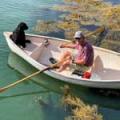
Named for the woman who represented Maine in Congress from 1940 until 1973, the
Margaret Chase Smith ferry has been in service since 1987. It can carry up to 250 passengers and 33 cars. Photo by Tom Groening
By Paige Taylor
The annoying beep of my alarm clock interrupts my sleep. It’s 6:22 a.m., time to get up and start the day. My younger sister and I leave our house in Belfast at 7:20 a.m. to meet up with the four other students in our carpool. After the 15-minute drive, we arrive at the Lincolnville terminal with plenty of time to spare before the 8 a.m. ferry leaves.
This is my daily routine.

Editor’s note:
A fact of life in a state with as many islands
as Maine is that dozens of students commute
to school over the water. For 15 years, Islesboro
Central School has accepted a handful of grade
5-12 students from the mainland into a special
magnet program. The students apply to the
program, which is quite competitive, and once
accepted pay a small tuition. Currently 23
students from Belfast, Camden, Montville,
Rockland, and Rockport commute daily to
the island school, according to Islesboro
Principal Heather Knight. We asked Paige
Taylor of Belfast, shown here, to write about
her commute.
Photo by Emma Bowe
While most students get to school by bus or car, I’ve been riding the
Margaret Chase Smith ferry twice a day for five years, commuting from the mainland to Islesboro as a participant in the Islesboro Central School magnet program. I have been a student there since sixth grade and am now in my junior year.
I line up at the ticket window to get my green round-trip pass, and wait. The boat hasn’t docked yet. A group of students sit half asleep in the terminal, waiting until the last minute to go out into the freezing wind. When the ferry arrives and the cars start to unload, then we head out. The water looks grey and unwelcoming on this cold fall day. We stand in the outdoor passenger waiting area for only five minutes, but the north wind blowing in our faces makes it feel like an hour. Finally we are waved onboard the ferry.
Many things drew me to go to school on the island. First, would be the small size. There are about 100 students in the kindergarten through 12th grade school, with only 10 people in my junior class. My largest class this year has about 18 students and the smallest seven. The small classes allow us to make close friends and get to know our teachers better—and it’s easy to get extra help or just talk outside of class with a teacher.
The commute has its ups and its downs. While the three-mile, fifteen-minute long ferry ride can be a nice break, it also makes being part of the school community harder. The magnet students have to schedule our school lives around the ferry. Also, while the islanders are welcoming to the magnet students, we are not really a part of the island community—we are only there during school. Still, being a magnet student has given me a small taste of what living on an island is like. I have made friends there and gotten to know others who live there full time. If you get stuck on the island due to weather, which has never happened to me in the five years I have gone to Islesboro, you are assigned a host family for the night. While I enjoy going to school on Islesboro, I would probably never want to live on an island, though. It is too isolated. I like going out and doing things, like eating out and going to the movies.
Back on the morning ferry, we sit in our usual front section in seats that students who boarded earlier have saved for us. Some of the ferry’s plastic orange benches have names and messages carved on them. A couple of students who procrastinated on their math homework scramble to get it done during the ride. Others chat with each other. Some of us who are still half asleep listen to music. Other friends are busy with knitting projects. A couple of the teachers, also commuting from the mainland, talk with each other. The rest of the cabin is filled mostly with construction workers who chat quietly or read the
Bangor Daily News. Most of their faces have become familiar over the past few months, some over the past years.
The ferry leaves the dock. The waves are a little rough, but nothing really out of the ordinary. Out of all the Maine ferries, the
Margaret Chase Smith is one of the largest, holding around 30 vehicles and 250 passengers. It makes runs daily leaving on the hour from Lincolnville and every half hour from Islesboro in the summer. In the winter the ferry does not run as often.
I could not imagine going to school anywhere else or by any other route. My life would seem empty without the ferry ride, my fellow commuters, and the views of Penobscot Bay. During summer vacation, I don’t really miss school, but I miss the ferry ride. Being on the ferry gives me time every day to hang out with friends, without adults. It also gives me time to prepare mentally for school. Plus, riding the boat through all the seasons is interesting. During the warmer months, we meet tourists mixed in with the regular commuters. In the winter we see the sun setting behind the Camden hills. In the spring and fall, the bright sun makes the water sparkle. Sometimes we even spot a porpoise or two.
We finally arrive on the island. People gather their things and finish whatever they were doing. The students working on their homework are scribbling down the last sentences as fast as they can. A crowd of people waits for the last car to unload. Then we walk together to the parking lot where a school bus waits for students and teachers to take us the final few miles to school.
For More Information:
For more about the Islesboro Magnet Program and other students who commute across the water to school, see a related story at
www.maineboats.com Named for the woman who represented Maine in Congress from 1940 until 1973, the Margaret Chase Smith ferry has been in service since 1987. It can carry up to 250 passengers and 33 cars. Photo by Tom Groening
Named for the woman who represented Maine in Congress from 1940 until 1973, the Margaret Chase Smith ferry has been in service since 1987. It can carry up to 250 passengers and 33 cars. Photo by Tom Groening  Editor’s note:
A fact of life in a state with as many islands
as Maine is that dozens of students commute
to school over the water. For 15 years, Islesboro
Central School has accepted a handful of grade
5-12 students from the mainland into a special
magnet program. The students apply to the
program, which is quite competitive, and once
accepted pay a small tuition. Currently 23
students from Belfast, Camden, Montville,
Rockland, and Rockport commute daily to
the island school, according to Islesboro
Principal Heather Knight. We asked Paige
Taylor of Belfast, shown here, to write about
her commute.
Photo by Emma Bowe
Editor’s note:
A fact of life in a state with as many islands
as Maine is that dozens of students commute
to school over the water. For 15 years, Islesboro
Central School has accepted a handful of grade
5-12 students from the mainland into a special
magnet program. The students apply to the
program, which is quite competitive, and once
accepted pay a small tuition. Currently 23
students from Belfast, Camden, Montville,
Rockland, and Rockport commute daily to
the island school, according to Islesboro
Principal Heather Knight. We asked Paige
Taylor of Belfast, shown here, to write about
her commute.
Photo by Emma Bowe
















